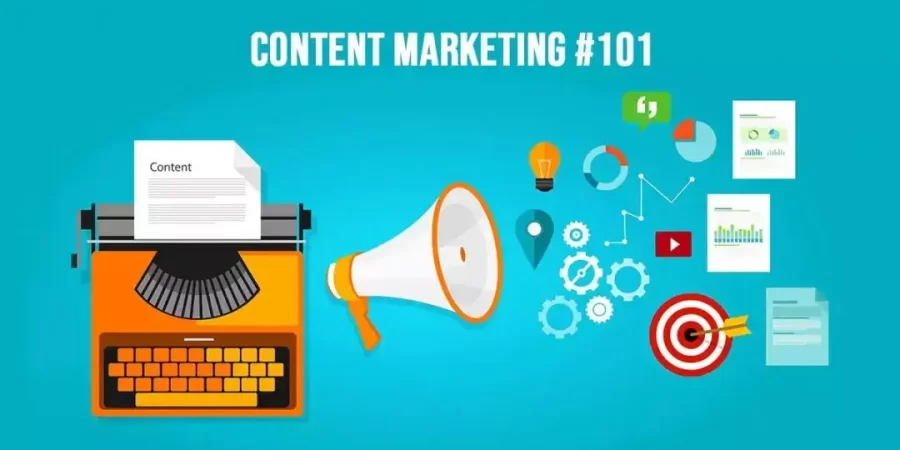Content Marketing 101 Guide For Beginners
Content marketing is a strategy used by businesses to create and distribute valuable, relevant, and consistent content to attract and engage a specific audience, ultimately driving profitable customer action. It is a way to connect with your target market and establish yourself as an authority in your industry. In this guide, we will cover the basics of content marketing for beginners, including what it is, why it’s important, and how to create and implement a content marketing strategy.
First, let’s define what content marketing is. At its core, content marketing is about creating and sharing valuable and informative content with the purpose of engaging your target audience and driving profitable customer action. This can include blog posts, videos, infographics, social media posts, and more. The key is that the content is relevant and helpful to your target audience, not just promotional or sales-focused.
Now, why is content marketing important? In today’s digital age, consumers are bombarded with advertising and marketing messages everywhere they turn. In order to stand out and capture the attention of your target audience, you need to provide them with valuable and relevant content that they will find helpful and informative. By doing so, you will establish trust and credibility with your audience, which in turn will lead to increased brand loyalty and sales.
Now that we’ve covered what content marketing is and why it’s important, let’s talk about how to create and implement a content marketing strategy.
- Define your target audience: The first step in creating a content marketing strategy is to define your target audience. You need to know who you are trying to reach in order to create content that will be relevant and valuable to them. Consider factors such as demographics, interests, pain points, and goals when defining your target audience.
- Identify your goals: Once you know who your target audience is, you need to identify what you want to achieve with your content marketing efforts. Some common goals include increasing brand awareness, driving website traffic, and generating leads and sales.
- Conduct a content audit: Before you begin creating new content, take a look at the content you already have. Conduct a content audit to identify what’s working and what’s not. This will help you determine what types of content your audience is most interested in and what gaps you need to fill.
- Create a content calendar: Once you know what types of content your audience is interested in and what your goals are, you can create a content calendar. This will help you stay organized and ensure that you are consistently creating and publishing new content.
- Create valuable and relevant content: This is the most important step in content marketing. Your content should be valuable and relevant to your target audience. It should educate, inform, and entertain them. Consider creating a variety of different types of content, such as blog posts, videos, infographics, and social media posts.
- Promote your content: Once you’ve created your content, you need to promote it. Share it on social media, include it in email campaigns, and reach out to influencers in your industry to share it as well.
- Measure and analyze your results: Finally, it’s important to measure and analyze the results of your content marketing efforts. Use tools like Google Analytics to track website traffic and engagement, and use this information to adjust your strategy as needed.
- Use SEO tactics: One of the most important aspects of content marketing is making sure that your content is easily discoverable by your target audience. This is where SEO comes in. By incorporating SEO tactics, such as keyword research, meta tags, and alt tags, you can increase the visibility of your content on search engines like Google.
- Optimize for different platforms: It’s important to remember that not all content is created equal and not all platforms are suitable for every type of content. For example, a video might perform better on YouTube than on Instagram. Optimize your content for different platforms to ensure that it reaches the right audience.
- Repurpose your content: Creating new content can be time-consuming and expensive. One way to maximize your content marketing efforts is to repurpose existing content. For example, you can turn a blog post into an infographic or a podcast.
- Use visuals: Visuals are a great way to grab the attention of your target audience. Use images, videos, and infographics in your content to make it more engaging and shareable.
- Engage with your audience: Content marketing is not a one-way street. It’s important to engage with your audience by responding to comments and feedback, hosting Q&A sessions, and creating opportunities for them to share their own content.
- Collaborate with influencers: Influencer marketing is a great way to reach a new audience and establish credibility. Collaborate with influencers in your industry to create content that will be seen by their followers.
- Test, Test, Test: There is no magic formula for content marketing success. The best way to know what works is to experiment with different types of content and see what resonates with your audience. Test different headlines, images, and calls-to-action to see what gets the most engagement.
Content marketing is a great way to connect with your target audience and grow your business. By following the tips outlined in this guide, you will be able to create a content marketing strategy that works for your business. However, it’s important to remember that content marketing is an ongoing process. Continuously analyze and adjust your strategy to ensure that it is effective.
- Content marketing is a strategy used to create and distribute valuable, relevant and consistent content to attract and engage a specific audience and ultimately drive profitable customer action.
- It is important to define your target audience, identify your goals and conduct a content audit before creating new content.
- Create a content calendar, valuables and relevant content, and promote it using different channels.
- Use SEO tactics, optimize for different platforms, repurpose existing content and use visuals.
- Engage with your audience, collaborate with influencers, and continuously test and analyze your strategy.
- Content marketing is an ongoing process and it’s important to continuously adjust your strategy to ensure it is effective.
In conclusion, content marketing is an essential strategy for businesses looking to connect with their target audience and establish themselves as industry leaders. By creating valuable, relevant and consistent content, businesses can attract and engage their target audience, build trust and credibility and ultimately drive profitable customer action. The steps outlined in this guide, such as defining your target audience, identifying goals, creating a content calendar, and promoting your content, are all crucial for creating a successful content marketing strategy.
Additionally, incorporating SEO tactics, optimizing for different platforms, repurposing existing content, using visuals, engaging with your audience, collaborating with influencers and continuously testing and analyzing your strategy can help to maximize the effectiveness of your content marketing efforts. Overall, content marketing is an ongoing process that requires commitment and dedication, but by following these guidelines, businesses can create a content marketing strategy that drives real results.





Leave a Reply